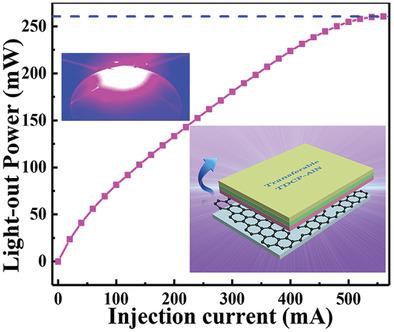当前位置:
X-MOL 学术
›
Adv. Opt. Mater.
›
论文详情
Our official English website, www.x-mol.net, welcomes your
feedback! (Note: you will need to create a separate account there.)
Transferable GaN Enabled by Selective Nucleation of AlN on Graphene for High‐Brightness Violet Light‐Emitting Diodes
Advanced Optical Materials ( IF 8.0 ) Pub Date : 2019-11-25 , DOI: 10.1002/adom.201901632 Yanqing Jia 1 , Jing Ning 1 , Jincheng Zhang 1 , Chaochao Yan 1 , Boyu Wang 1 , Yachao Zhang 1 , Jiaduo Zhu 1 , Xue Shen 1 , Jianguo Dong 1 , Dong Wang 1 , Yue Hao 1
Advanced Optical Materials ( IF 8.0 ) Pub Date : 2019-11-25 , DOI: 10.1002/adom.201901632 Yanqing Jia 1 , Jing Ning 1 , Jincheng Zhang 1 , Chaochao Yan 1 , Boyu Wang 1 , Yachao Zhang 1 , Jiaduo Zhu 1 , Xue Shen 1 , Jianguo Dong 1 , Dong Wang 1 , Yue Hao 1
Affiliation

|
A transferable GaN epilayer is grown on an improved aluminum nitride (AlN)/graphene composite substrate. In this study, theoretical calculations using first‐principles calculations based on density functional theory are carefully conducted to further examine the formation mechanism of AlN on graphene. AlN selectively grows on graphene via its optimal nucleation site, which leads to the selective nucleation of AlN on graphene via quasi‐van der Waals epitaxy. Thus, an AlN composite nucleation layer is innovatively inserted between graphene and GaN, using the time‐distributed and constant‐pressure growth method by metal organic chemical vapor deposition. Moreover, a high‐quality GaN epilayer can be grown while ensuring the successful exfoliation of GaN by overcoming weak van der Waals forces between the graphene and the epilayer. The as‐fabricated violet light‐emitting diodes (LEDs) deliver an ultrahigh light output power. This method demonstrates the possibility of achieving a high‐quality vertical structure for LEDs and the ability to mechanically transfer to achieve flexible lighting.
中文翻译:

氮化镓在石墨烯上的选择性成核作用实现了可转移的GaN,用于制造高亮度紫光发光二极管
可转移的GaN外延层生长在改进的氮化铝(AlN)/石墨烯复合衬底上。在这项研究中,认真地进行了基于密度泛函理论的第一性原理计算的理论计算,以进一步检验AlN在石墨烯上的形成机理。AlN通过其最佳成核位点选择性地在石墨烯上生长,这导致AlN在石墨烯上通过准Van der Waals外延选择性成核。因此,使用时间分布和恒压生长方法通过金属有机化学气相沉积,在石墨烯和GaN之间创新地插入了AlN复合成核层。此外,可以生长高质量的GaN外延层,同时通过克服石墨烯与外延层之间的弱范德华力来确保GaN成功剥离。预制的紫罗兰色发光二极管(LED)可提供超高的光输出功率。该方法证明了为LED实现高质量垂直结构的可能性,以及机械转移以实现灵活照明的能力。
更新日期:2020-01-17
中文翻译:

氮化镓在石墨烯上的选择性成核作用实现了可转移的GaN,用于制造高亮度紫光发光二极管
可转移的GaN外延层生长在改进的氮化铝(AlN)/石墨烯复合衬底上。在这项研究中,认真地进行了基于密度泛函理论的第一性原理计算的理论计算,以进一步检验AlN在石墨烯上的形成机理。AlN通过其最佳成核位点选择性地在石墨烯上生长,这导致AlN在石墨烯上通过准Van der Waals外延选择性成核。因此,使用时间分布和恒压生长方法通过金属有机化学气相沉积,在石墨烯和GaN之间创新地插入了AlN复合成核层。此外,可以生长高质量的GaN外延层,同时通过克服石墨烯与外延层之间的弱范德华力来确保GaN成功剥离。预制的紫罗兰色发光二极管(LED)可提供超高的光输出功率。该方法证明了为LED实现高质量垂直结构的可能性,以及机械转移以实现灵活照明的能力。











































 京公网安备 11010802027423号
京公网安备 11010802027423号